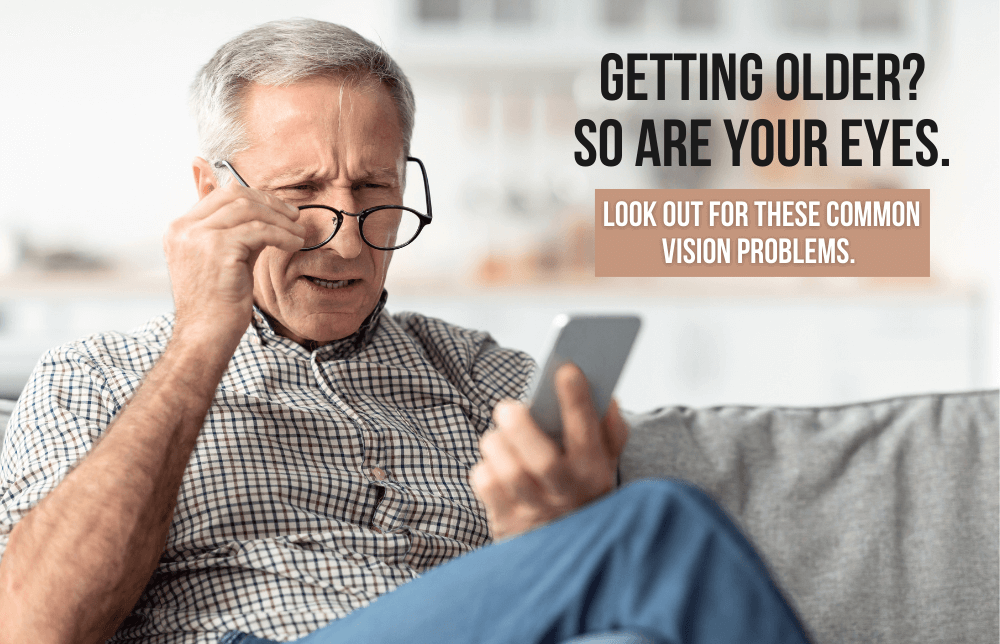
As we get older, it’s normal to notice some vision problems. Issues like difficulty telling colors apart and taking more time to adapt to changes in the amount of light are all too common. Daily activities like looking at a computer screen or exchanging text messages on your phone or spending time outside without protective sunglasses can increase risks for eyestrain and vision problems.
Aging Vision Means Common Vision Problems
As the years tick by, it’s common to have more problems regarding your vision. Many older people find themselves having increased difficulty seeing things up close, distinguishing between colors and noticing more sensitivity to glare and needing more light for specific tasks.
A lot of the problems you might encounter with aging eyes stem from specific conditions. Here are some to keep on your radar.
Presbyopia
Have you noticed you’re squinting at menus or turning up the brightness to try and read texts on your phone? You might have presbyopia, or age-related farsightedness.
After age 40, most people will deal with some level of gradual loss of their eyes’ ability to focus on nearby objects. Fortunately, there are plenty of options for correcting this issue, from eyeglasses and contacts to surgical solutions.
Age-related macular degeneration
Age-related macular degeneration is a leading cause of vision problems, including vision loss, in people over 50. This condition affects your central vision but leaves your peripheral vision unchanged. You get AMD when your macula, a key part of your retina, changes. Most people get dry AMD, which causes you to lose your central vision slowly over time.
Dry eyes
Dry eyes don’t just cause redness, a stinging sensation, and discomfort. The condition can also blur your vision. People of all ages deal with dry eyes, but the issue is most frequent for older people. This is because our bodies make fewer tears as we get older. After age 65, it’s highly likely for people to have some dry eye symptoms.
Fortunately, over-the-counter artificial tears are an easy solution for many people.
Glaucoma
Glaucoma is a blanket term for a variety of conditions related to damage to the optic nerve that can cause serious vision problems. Open-angle glaucoma, the most common type, usually doesn’t cause symptoms at first, but slowly deteriorates the peripheral vision. Without treatment to relieve the pressure on the optic nerve and prevent further vision loss, the condition can eventually lead to total blindness.
Cataracts
More than 50% of Americans over the age of 80 either have cataracts or have had them removed.
Cataracts are caused by the proteins in the eye start to break down and clump together. Over time, this causes visible cloudiness in the eye and makes vision fuzzy, causes colors to look faded and diminishes night vision.
While different eyeglasses or contact lens prescriptions can help, many eye doctors eventually recommend surgery to remove the cataract.
Common Vision Problems and Solutions
Aging eyes can mean problems down the road, but with regular eye checkups, your chances of catching problems early on are far greater. A good eye doctor can evaluate your eyes and catch issues early when they’re easiest to treat. That’s why the Vision Plan from your association and AMBA is so important. The plan covers annual WellVision exams, 100% coverage for most lenses, even progressives, and thousands of nationwide in-network providers. Sign up today – acceptance is GUARANTEED! – at www.AMBAdentalvision.com or call 866-979-0497.
Source: https://www.mayoclinic.org/diseases-conditions/presbyopia/symptoms-causes/syc-20363328
https://www.nei.nih.gov/learn-about-eye-health/eye-conditions-and-diseases/glaucoma




